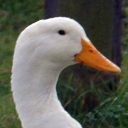The mallard (Anas platyrhynchos) is a dabbling duck that breeds throughout the temperate and subtropical Americas, Eurasia, and North Africa and has been widely introduced around the globe. Unlike many waterfowl, mallards are considered an invasive species in some regions. The non-migratory mallard interbreeds with indigenous wild ducks of closely related species, producing fertile offspring.
Mallards are differentiated in their mitochondrial DNA between North American and Eurasian populations, but the nuclear genome displays a notable lack of genetic structure. Mitochondrial DNA data for the D-loop sequence suggests that mallards may have evolved in the general area of Siberia. Mallard bones rather abruptly appear in food remains of ancient humans and other deposits of fossil bones in Europe, without a good candidate for a local predecessor species.
Assembly
The CAU_duck1.0 assembly was submitted by China Agricultural University on November 2017. The assembly is on chromosome level, consisting of 44,791 contigs assembled into 21,240 scaffolds. From these sequences, 29 chromosomes have been built. The N50 size is the length such that 50% of the assembled genome lies in blocks of the N50 size or longer. The N50 length for the contigs is 88,037 while the scaffold N50 is 74,988,519.
Gene annotation
The gene annotation process was carried out using a combination of protein-to-genome alignments, annotation mapping from a suitable reference species and RNA-seq alignments (where RNA-seq data with appropriate meta data were publicly available). For each candidate gene region, a selection process was applied to choose the most appropriate set of transcripts based on evolutionary distance, experimental evidence for the source data and quality of the alignments.Small ncRNAs were obtained using a combination of BLAST and Infernal/RNAfold. Pseudogenes were calculated by looking at genes with a large percentage of non-biological introns (introns of <10bp), where the gene was covered in repeats, or where the gene was single exon and evidence of a functional multi-exon paralog was found elsewhere in the genome. lincRNAs were generated via RNA-seq data where no evidence of protein homology or protein domains could be found in the transcript.
In accordance with the Fort Lauderdale Agreement, please check the publication status of the genome/assembly before publishing any genome-wide analyses using these data.
More information
General information about this species can be found in Wikipedia.
Statistics
Summary
| Assembly | CAU_duck1.0, INSDC Assembly GCA_002743455.1, Nov 2017 |
| Base Pairs | 1,136,415,614 |
| Golden Path Length | 1,136,415,614 |
| Annotation provider | Ensembl |
| Annotation method | Full genebuild |
| Genebuild started | Oct 2018 |
| Genebuild released | Apr 2019 |
| Genebuild last updated/patched | Mar 2020 |
| Database version | 111.1 |
Gene counts
| Coding genes | 16,618 |
| Non coding genes | 9,285 |
| Small non coding genes | 432 |
| Long non coding genes | 8,731 |
| Misc non coding genes | 122 |
| Pseudogenes | 49 |
| Gene transcripts | 42,943 |
Other
| Genscan gene predictions | 48,368 |
